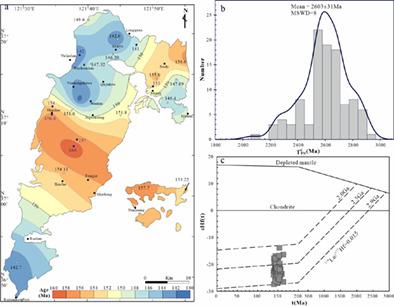当前位置:
X-MOL 学术
›
Geolog. J.
›
论文详情
Our official English website, www.x-mol.net, welcomes your
feedback! (Note: you will need to create a separate account there.)
Petrogenesis and tectonic implication of the Late Jurassic Kunyushan granitic complex in the Jiaodong Peninsula, eastern China
Geological Journal ( IF 1.4 ) Pub Date : 2021-02-15 , DOI: 10.1002/gj.4101 JiangTao He 1, 2 , JunJian Li 2 , Chao Fu 2 , HongYing Zhou 2 , XiuZhang Li 3 , ZhiCai Dang 2 , JiePeng Tian 4 , WenLong Tang 2
Geological Journal ( IF 1.4 ) Pub Date : 2021-02-15 , DOI: 10.1002/gj.4101 JiangTao He 1, 2 , JunJian Li 2 , Chao Fu 2 , HongYing Zhou 2 , XiuZhang Li 3 , ZhiCai Dang 2 , JiePeng Tian 4 , WenLong Tang 2
Affiliation

|
The Kunyushan granitic complex in the Jiaodong Peninsula, East China, is located in the northeast part of the Sulu UHP metamorphic belt. It is the transition belt of the North China Craton and Sulu UHP metamorphic belt. Field relationship and dating results revealed five intrusive phases of the Kunyushan granitic complex were modified into gneissic fine-grained garnet-bearing monzogranite (G1), gneissic medium- to fine-grained monzogranite (G2), medium- to coarse-grained monzogranite (G3), medium-grained monzogranite (G4), and porphyritic coarse- to medium-grained monzogranite (G5). All these phases have similar rock assemblages of peraluminous, calc-alkaline, I-type monzogranites. The monzogranites had primitive mantle-normalized patterns enriched in light rare earth elements (LREE) and lithophile elements (Sr, Ba, and Rb), but depleted in heavy rare earth elements (HREE) and high-field-strength elements (Nb, P, and Ti). LA-ICP-MS zircon U–Pb dating shows that the crystallization age of the Kunyushan granitic complex extends at least from 157.7–142.0 Ma. The weighted average ages of G1-G5 were 145.6 ± 1.9 Ma, 145.8 ± 0.5 Ma, 147.2 ± 0.7 Ma, 154.2 ± 0.6 Ma, and 155.0 ± 0.7 Ma, respectively. G5 to G1, from the middle to the edge shows a trend of gradually becoming younger. Zircon grains from different phases have similar 176Hf/177Hf values from 0.281917 to 0.282298, and εHf(t) values from −27.6 to −14.0, with a weighted average of −22.6 ± 0.5, typical of crustal-derived origin. The corresponding two-stage model ages TCDM are from 2,910 to 2,066 Ma, with a weighted average of 2,603 ± 31 Ma. Hf–Sr–Nd–Pb isotopes and inherited zircons suggest that the parental magma of the Kunyushan granitic complex was derived from melting of basement rocks of the North China Craton and the Yangtze Craton. The magmatism presumably took place under the background of subduction and back-arc extension of the Palaeo-Pacific plate. We infer that the Kunyushan granitic complex was produced by partial melting of the thickened lower crust, through delamination of the thickened lower crust during the Late Jurassic. This magmatic event may mark the beginning of the extensive Mesozoic thinning of the lithosphere in East China.
更新日期:2021-02-15











































 京公网安备 11010802027423号
京公网安备 11010802027423号